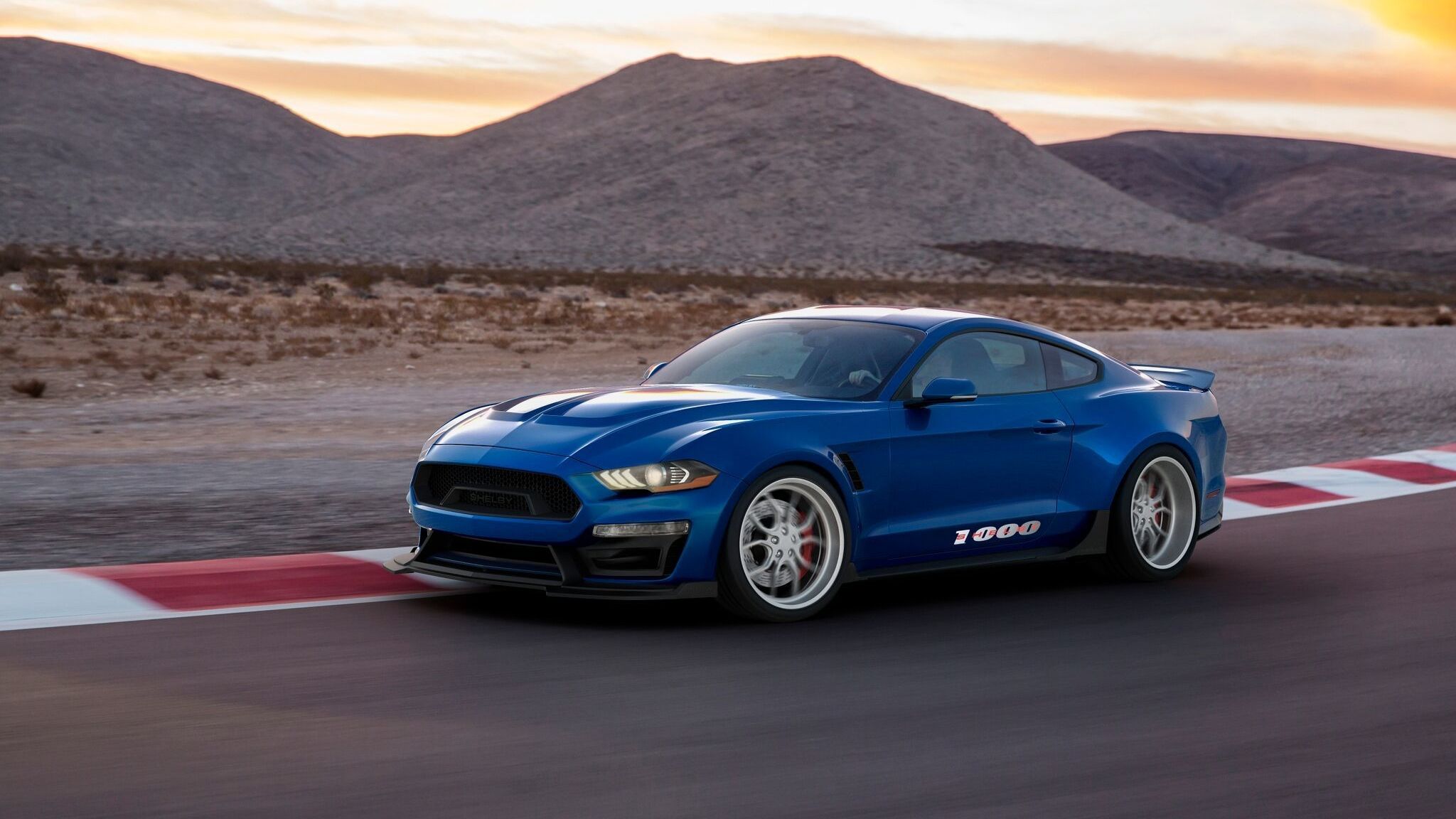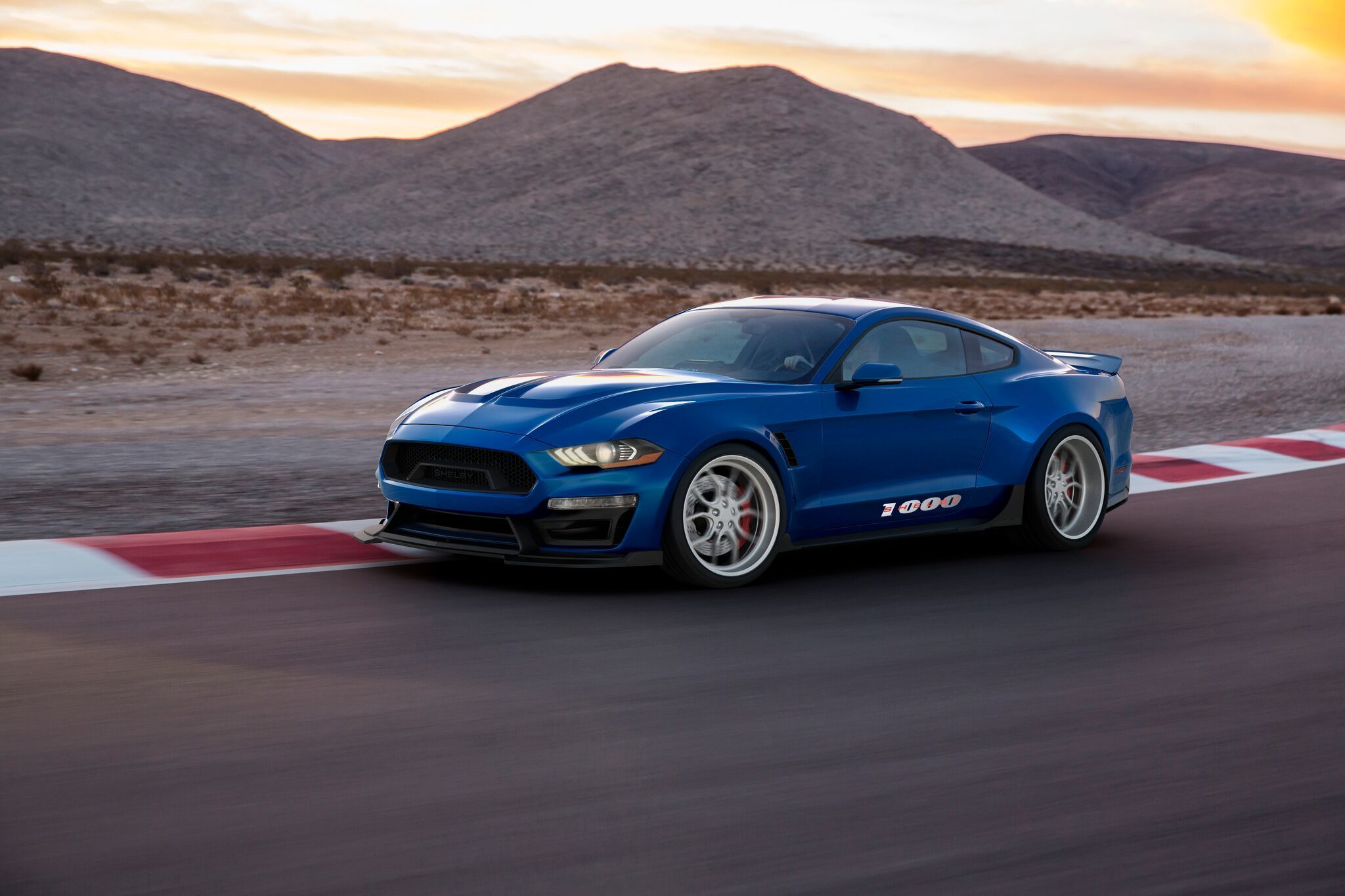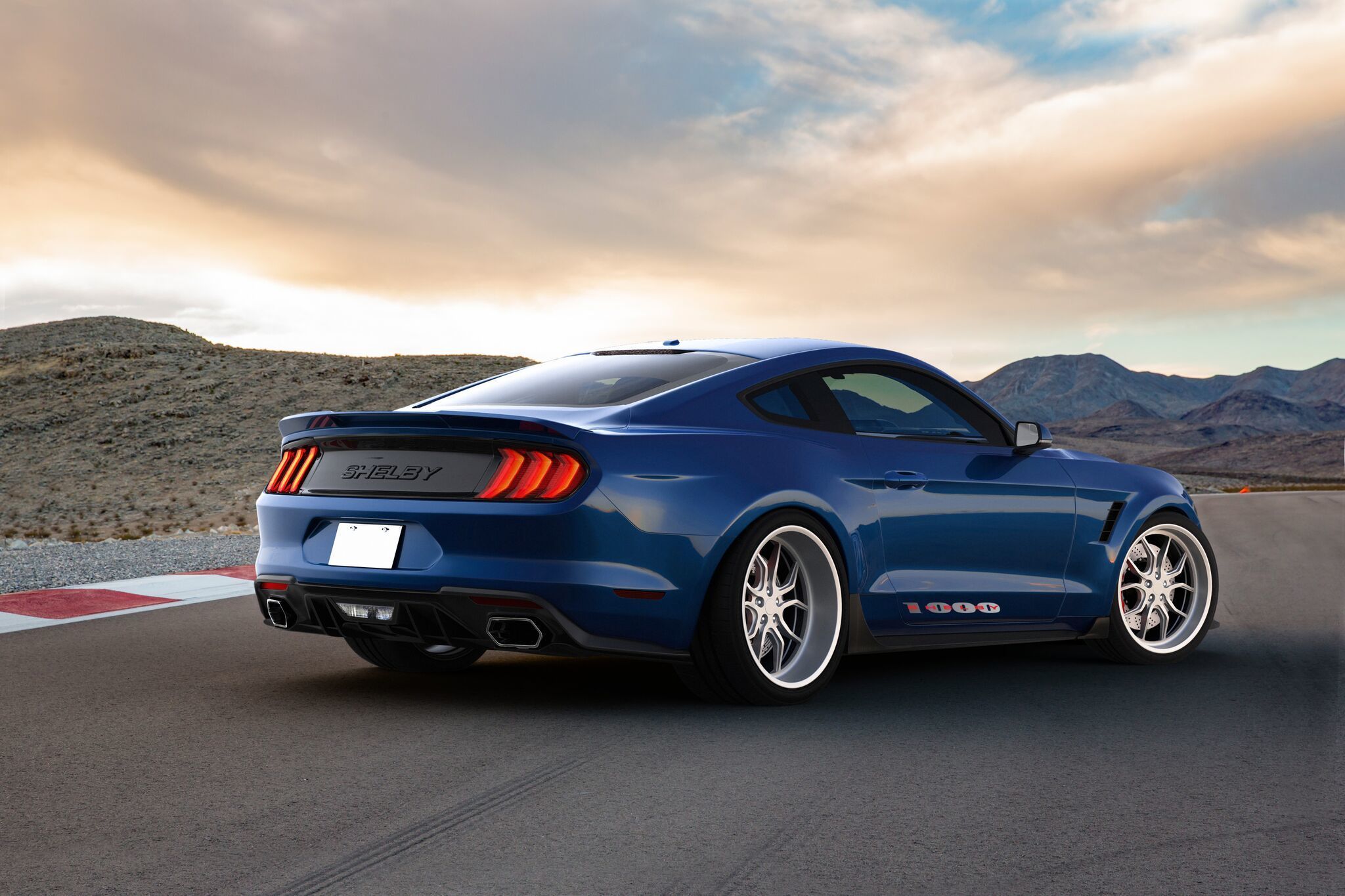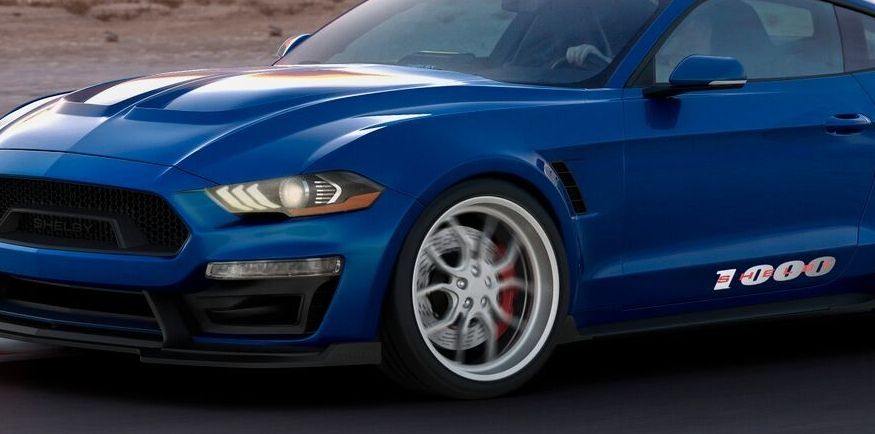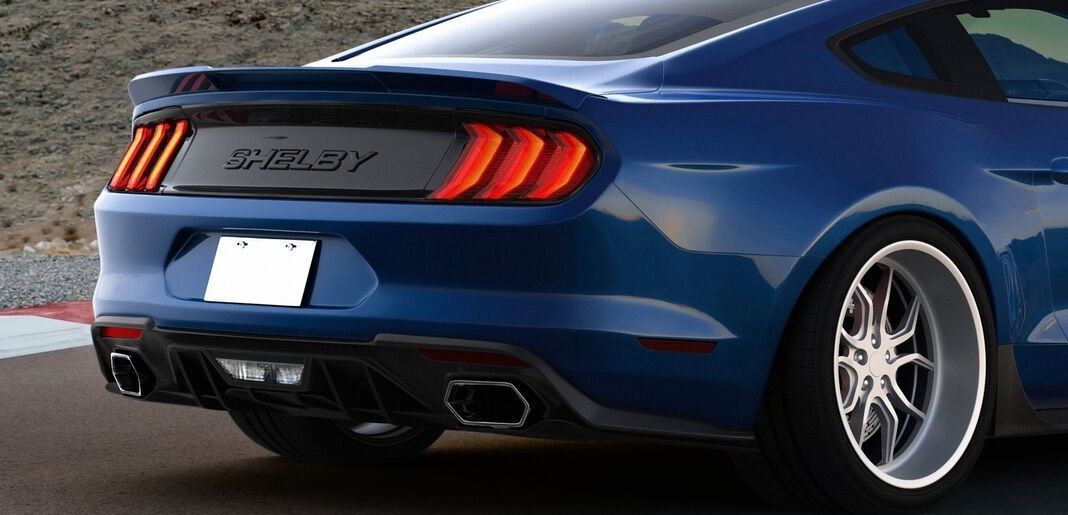It's been only four three model years since the sixth-generation Ford Mustang arrived in showrooms, and the pony has already spawned an impressive number of versions wearing the Shelby badge. Although the iconic GT500 has yet to be revived, Ford has already launched the GT350, the Super Snake, GT-H, and GTE, just to name a few. The GT500 may still be a year away, but sixth-gen Mustang, but Shelby just launched yet another performance model. This time around it's the Shelby 1000, the brand's most menacing creation in terms of output and straight-line speed.
The Shelby 1000 is closely related to the GT500, as the first model to wear this badge, launched in 2011, was based on the fifth-generation GT500. Offered in both street and 1000 S/C track versions, the first iteration of the car was discontinued in 2012. The 1000 returned in 2013, once again based on the GT500, but now with the 5.8-liter V-8 instead of the old 5.4-liter unit under the hood. Both the street package and the S/C track package were offered. Also available as an upgrade for the GT500, the package was discontinued in 2014, after only two years on the market. The new Shelby 1000 is the first such model based on the sixth-generation Mustang, so everything about it is new compared to previous iterations. Let's have a closer look at the car in the review below.
Continue reading to learn more about the Ford Shelby Mustang 1000.
2018 Ford Shelby Mustang 1000
- Make: Array
- Model: 2018 Ford Shelby Mustang 1000
- Engine/Motor: V8
- Horsepower: 1500
- [do not use] Vehicle Model: Array
Exterior
Ever since it was introduced in 2011, the Shelby 1000 made a name for itself as the most aggressive road-legal production version of the Mustang in terms of exterior design. The new model is no exception from this rule and looks even more menacing on the styling cues of the facelifted, sixth-generation 'Stang.
As usual, it sports wider than usual fenders. These were added to make way for fatter tires, but also to give the car a wider stance for increased stability and a more aggressive look. Shelby redesigned both the nose and the bumper. The grille now features a honeycomb mesh and a trapezoidal element at the bottom with "Shelby" lettering inside.
Below, we can see larger side cooling ducts, a more aggressive lower grille, and a bigger splitter. The hood is new as well, now sporting a massive center bulge and big vents, both added to accommodate the supercharged engine.
Moving onto the sides, we can see a new vent on the front fender, black side sill extensions, and "Shelby 1000" lettering on the lower door area. The standard Mustang wheels have been ditched for 20-inch, forged aluminum rollers with a twin-five-spoke design. Around back, there's a new spoiler atop the trunk lid and a new, more aggressive diffuser with wide exhaust pipes below the bumper. As usual, the black panel between the taillights comes with "Shelby" lettering.
Interior
Note: Standard 2018 Ford Mustang pictured here.
Shelby has yet to release interior shots of the 1000, but it did post a list of upgrades it made to the sixth-generation Mustang. Open the door and you'll be greeted by special, illuminated Shelby sill plates. You'll notice almost immediately that the front seats are wrapped in Katzkin leather. Because this car was built with racing in mind, the rear seats have been removed and a four-point roll-bar and harness system was added for enhanced safety. Other highlights include an instrument with Shelby by Autometer gauges, CSM badging on the dashboard, and custom floor mats.
In addition to all of the above, customers will benefit from the sixth-gen Mustang's redesigned interior. Despite this model being almost four years old as of 2017, I'm mentioning it because this is the first Shelby 1000 based on it. So the new 1000 will have quite a few features to stand out by compared to previous versions of the supercharged coupe, including a redesigned dashboard with a more modern design, fresh technology, softer materials, and a bit more room.
Note: Standard 2018 Ford Mustang pictured here.
Those who opt to have the Shelby 1000 update on the facelifted, 2018-model-year 'Stang will also benefit from hand-made contrast stitching, padded knee bolsters, and aluminum door handles, rings, and bezels. You can even have a heated steering wheel if you check the option on Ford's ordering list.
In terms of new-for-2018 tech, there's a 12-inch digital instrument cluster with a personalized LCD and Ford SYNC Connect with FordPass. Available as an option, the latter is an app that enables drivers to start, lock, unlock, and locate their car using smartphones.
Note: Standard 2018 Ford Mustang pictured here.0}
Note: 2017 Ford Shelby GT350 Mustang pictured here.
As it is the case with most Shelby muscle cars, most of the upgrades are hidden under the engine hood. The 1000 update ditches the 5.0-liter V-8 that comes with the Mustang GT, replaced by a larger, 5.2-liter unit. If it sounds familiar it's because Shelby is using the same engine found in the cool GT350. However, while the GT350 is a naturally aspirated car, the Shelby 1000 also gets a 4.5-liter, Whipple-designed supercharger.
The assembly also gets new radiator, heat exchanger, oil cooling, and an aluminum cooling tank, as well as a Shelby exhaust with long tube headers. It mates to a new manual transmission with revised cooling parts and a short throw shifter. There's also a one-piece drive shaft, a truple disk clutch, and a Shelby fuel pickup system. Driveline upgrades are rounded off by an oil recovery system, an ATI vibration dampener, and a high capacity oil pan.
The new axles are rated at a whopping 1,500 horsepower. Speaking of which, Shelby has yet to announce the power rating of the 1000 model, but if the past is any indication, you can specify as much horsepower as the axles can handle. In this case, 1,500 horsepower. It's worth noting that the first-gen model developed 920 horses in road-legal specs, while the second-gen car was good for a whopping 1,200 horsepower. Assuming that Shelby will offer two power ratings, expect at least 1,000 horsepower from the base model.
But the Shelby 1000 isn't just about engine upgrades. The chassis has been heavily modified too and now includes revised front spindle and control arms, new rear lower control arms, Penske adjustable shocks and springs, a caster camber plates and adjustable sway bar link, Ford Performance sway bars, Ford Performance half shafts, a Brembo brake system, and further frame strengthening. The wheels, which feature hardened studs, are wrapped in Michelin Pilot Sport 4S tires for enhanced grip.
Of course, you're probably asking how fast this car is in a straight line. It's difficult to tell without actual specs, but it should be the quickest Shelby ever created. If you really need a figure, it's safe to assume that it will hit 60 mph from a standing start in less than 2.5 seconds. Actually, it could be almost as quick as the Dodge Challenger Demon, which needs only 2.3 ticks.
Interestingly enough, Shelby claims that the new 1000 is an entirely different car compared to its predecessors, as it has been designed to be the "ultimate road course warrior." But this mission was far from easy, according to the firm, which said that modifying the sixth-generation Mustang was far more complication due to the independent rear suspension system and the new platform.
"Since Ford dropped the solid axle rear end, we had to take an entirely new approach," said Vince LaViolette, Shelby vice president and head of development. "Not only did we build strength into the car with components like heavy-duty halfshafts and CV joints, we revised the entire suspension by using tubular adjustable upper and lower control arms, as well as fully adjustable coilovers. We then added 10 and 12 inch forged wheels with sticky 20 inch rubber to maximize traction with this high level of power." While the previous generation Shelby 1000 was offered in both street and off-road configuration, a decision was made not to pursue emissions compliance on the new model, Shelby added, which makes the newest generation 1000 "purely a track star."
Prices
While the new Shelby 1000 package was advertised on the facelifted, 2018 Mustang, the upgrade is available for any sixth-generation Mustang GT. Production will be limited to only 50 units per year, but Shelby didn't say whether this edition will last more than the previous ones, which were around for only two model years each. Like any Shelby out there, each car will be documented in the official Shelby Registry. Pricing for the package is set at $169,995, not including the Ford Mustang GT. Add the base car, which retails from $35,095 before options, and the Shelby 1000 will cost you a whopping $205,090!
Competition
Dodge Challenger SRT Demon
When it comes to massive horsepower and drag-ready underpinnings, the Challenger Demon is the best competitor I can think of. Developed with fast quarter mile runs in mind, the Demon is a development of the Hellcat, but with significant upgrades in just about any department. The Demon is a Hellcat on steroids on the outside, featuring a new splitter, wider fender flares, and a beefed-up engine hood. Inside, the Demon is again similar to the Hellcat, but benefits from new seats with "Demon" logos, a bespoke instrument cluster, extra performance apps, and optional leather. The standard model comes with just the driver seat, but options include two- and five-seat layouts. Power comes from a souped-up supercharged, 6.2-liter V-8 that cranks out horsepower and 770 pound-feet of torque. It might not sound like much compared to the Shelby 1000, but the Demon needs only 2.3 seconds to hit 60 mph. However, this figure is achieved when the car is equipped with radial drag tires and used in Drag Mode. The Demon is also the fastest quarter-mile production car with a 9.65-second run at 140 mph. It's so quick that the NHRA actually issued a ban, as regulations state that a car that’s quicker than 9.99 seconds on the drag strip (at more than 135 mph) requires extra safety equipment and a racing license. This coupe is also fitted with a large number of upgrades developed to sustain the insane performance, including the SRT Power Chiller, TransBrake, and Bilstein shocks tuned for drag racing, just to name a few. Pricing starts from $84,995 (including $1,700 gas guzzler tax, excluding $1,095 destination), which makes it $20,800 more expensive than the Hellcat, but significantly more affordable than the Shelby 1000.
Read our full review of the 2018 Dodge Challenger SRT Demon.
Hennessey Camaro ZL1 "The Exorcist"
Built by Texas-based tuning company Hennessey, "The Exorcist" is not a factory-built car like the Demon, but it's put together in the same way as the Shelby 1000. And the outrageous power and its nickname make it a suitable rival for the other cars in this comparison. Built around the latest Chevy Camaro ZL1, "The Exorcist" has a supercharged, 6.2-liter V-8 rated at 1,000 horsepower and 966 pound-feet of torque and rides on drag slicks. The 0-to-60 mph sprint comes in "under three seconds" while the quarter-mile happens in "less than 10 seconds," which should be pretty close to the Shelby 1000. The good news is that even though it’s not a factory vehicle, the upgrade can be ordered through Chevrolet dealerships and comes with a two-year/24,000-mile warranty. What’s more, the 10-speed automatic transmission is joined by a six-speed manual, whereas the Demon can't be had with a stick. Pricing for this package starts from $55,000, not including the car, which means that the sticker actually begins from $116,140. Get all the options and "The Exorcist" will set you back a whopping $142,080. Far from affordable, but definitely not as expensive as the Shelby 1000.
Read our full story on the Hennessey Camaro ZL1 "The Exorcist."
Conclusion
The Shelby 1000 is far from being among the brand's most iconic nameplates. Because it's still relatively new, having been first introduced in 2011, it will be overshadowed by the GT350, GT500 and the Super Snake for many years to come. On the other, I have to give the 1000 credit for being the most extreme Shelby ever built. And with new axles rated at 1,500 horsepower, the new Shelby 1000 will be more powerful than ever. Granted, there's a chance it won't be as quick as the Challenger SRT Demon on the drag strip, but it will put any production muscle car and most aftermarket upgrades to shame in terms of horsepower. And needless to say, it doesn't look bad either. Put a big wing on that thing, and you'll have a full-fledged race car on your hands. The only downside here is that the Shelby 1000 is very expensive. You can buy a Porsche 911 GT3 and still have some $60,000 to spend on fuel and weekends at the Nurburgring.
References
Ford Mustang
Read our full review on the 2018 Ford Mustang.
Read our full review on the 2017 Ford Shelby GT350 Mustang.

